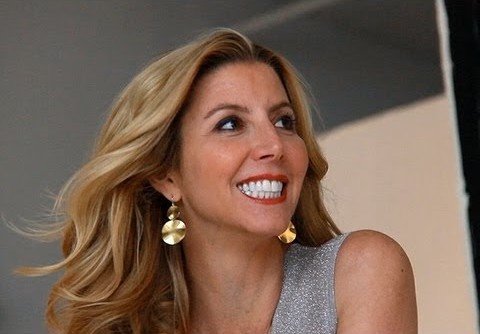stands topless at a conference room table. It’s Monday morning at the Spanx headquarters in Atlanta, and the founder of the hosiery company has been in a product development meeting for all of five minutes before walking out abruptly. She returns a minute later in nothing but a lacy taupe bra with black pants and beige wedges and adjusts herself in a full-length mirror, worrying aloud about the metal clasps on this early prototype. Will they create lumps under her clothes? Her CEO, Laurie Ann Goldman — petite and glamorous in a leopard print shift dress — tugs on Blakely’s straps.

The conference room looks like a boudoir designed by Willy Wonka: a jar of gum balls here, a loud houndstooth print there. Blakely hardly blinks in the presence of five colleagues and me as she removes the bra and tries on a second prototype. She’s been getting half-naked in public for the last decade, controlling every detail of the new category in women’s retail—shapewear—that she created from a one-product wonder sold out of her apartment.
Today Spanx is to slimming undergarments what Kleenex is to tissues: a brand that stands for the category. It nets an estimated 20% on revenue just south of $250 million. In recent months four Wall Street investment banks separately valued Spanx at an average $1 billion, a sum Forbes corroborated with the help of industry analysts. Blakely owns 100% of the private company, has zero debt, has never taken outside investment and hasn’t spent a nickel on advertising. At 41 she’s the youngest woman to join this year’s World’sBillionaires list without help from a husband or an inheritance. She is part of a tiny, elite club of American women worthten figures on their own, including Oprah Winfrey and Meg Whitman.
Lots of women, from Betty Grable to Kim Kardashian,have put their butts on the line to plump their profiles and profits. Far fewer have had to overcome three phobias—fear of heights, fear of flying and stage fright—to master the art of selling. Blakely is on the road “always,” she says. She feels dizzy in tall buildings (it doesn’t help to have a Manhattan condo on the 37th floor) and often cries in midair. She’s unwilling to board a plane without her iPod, so she can play the same Mark Knopfler song, “What It Is,” at every takeoff. “I have sweaty palms, panic attacks, my heart’s racing,” says Blakely, whose Floridian roots you occasionally hear in her “Ah” for “I.” She once had to muster the courage to hawk her wares 6 to 12 times a month on home shopping channel QVC; now that Spanx is so well-known, it’s maybe once a month but for hours at a time.
Blakely had early practice wrestling with anxiety when she occasionally did standup comedy. “Every time I went onstage I was so terrified I almost threw up,” she recalls. “I learned why they call it the greenroom.”
Spanx started as a one-woman show. In her first year Blakely shilled her new invention from a folding table in the foyer of Neiman Marcus, with a giant before-and-after photo of her derriere in cream slacks and bikini briefs underneath in one shot (an embarrassingly obvious Maginot Line) and $30 Spanx Power Panties (et voilà! no more line) in the other.
Over the last couple of years Spanx has depended less on Blakely’s face—and other body parts—to shift its shapers and stay ahead of a handful of copycats. The company is now run by a team of 125, only 16 of them men. It sells 200 products in 11,500 department stores, boutiques and online shops in 40 countries. Distributors worldwide clamor to get on the stockist list.
With international, we’re just warming up, says Goldman.
Blakely would still happily pose in nothing but Spanx on the cover of any of the nine catalogs mailed each year to 6 million shoppers, but she knows Goldman, 49, won’t go for it.
I’m game for anything, says Blakely. “The company has to pull me back.” Goldman, who created the first business plan at Spanx over the founder’s objections that it would stunt creativity, plays the straight man to Blakely’s more impulsive act.
Fueling her more impetuous side is her entrepreneurial twin: husband Jesse Itzler, 43, a former rapper from Long Island, who has backed and cofounded a few startups, including Marquis Jet, which sells fractional air-travel time. When I meet him at his midtown Manhattan office, he bounds up the stairs in a sweaty headband, his blond curls dripping. He’s come from an intense cardio workout with a Navy SEAL he hired to move in with him and Sara for a month. (This is more efficient than hiring rickshaws from his office, as he used to do, and paying the driver to be a passenger while he hauled the vehicle all the way home.)
Itzler regards Blakely’s accomplishments with amazement and amusement. “She’s 50% Lucille Ball, 50% Einstein. I keep a list of Sara-isms in my phone,” he says, referring to her goofy moments. “There’s something every day.”
Recent example: wearing two different shoes, one red-soled Christian Louboutin and one plain boot, and having to hobble up the escalator at Bloomingdale’s. Legend: On the way to the Screen Actors Guild Awards one year, Blakely realized in the limo she’d forgotten her jewelry at her hotel. Instead of turning back, she had her driver stop at a candy store—and accessorized her gown with stretchable candy necklaces and bracelets. Spanx fans recognize her on the street, in stores and in airports and want to show their allegiance. “Women flash her,” says Itzler. “Imagine that. She’s just really good. She’s the best, man.”
***
Blakely didn’t set out to invent anything, but she always had a knack for hucksterism. The daughter of a personal injury lawyer and an artist, she grew up in the beach town of Clearwater, Fla., always looking to make a buck.
She’d set up a haunted house at Halloween and charge her neighbors admission. Or, tearing a page from Tom Sawyer, she’d trick her friends into doing her chores by turning weedpulling into a competition. As a teen she pulled off a rare double act: popular blonde cheerleader and debate team champion (no performance anxiety then).
But tragedy eclipsed her sunny childhood. While riding a bike around her cul-de-sac, she saw a car run over her best friend, right in front of her. “I think that when you witness death at age 16, there’s a sense of urgency about life,” she says. “The thought of my mortality—I think about it a lot. I find it motivating. It can be any time that your number’s up.”
That same year Blakely’s parents separated. Not long afterward, both her prom dates died in horrible circumstances. She sought solace in her father’s Wayne Dyer cassette tapes, memorizing all ten volumes of the motivational speaker’s How to Be a No-Limit Person series. Dyer preaches “self-actualization” and “eliminating your erroneous zones.” She was so moved that she marched to her principal’s office to suggest they include the cassette tapes in the Clearwater High curriculum. Her friends couldn’t run the other way fast enough. “People used to fight over who had to ride home with me at night after a party,” says Blakely. “No one wanted to be in my car—they’d be, like, ‘No! She’s going to make us listen to that motivational crap!’”
Blakely started her first business in 1990, a kids’ club at the Clearwater Beach Hilton, charging $8 a child for a few hours of babysitting while moms and dads tanned. She was just out of high school, had no experience, no CPR training — and no insurance. She got away with it for three summers before trying to steal business from rival hotels’ summer programs. It was only when she went to pitch the Hilton’s general manager— age 20, in her first suit from Casual Corner—that she was busted. “He literally escorted me off the premises,” Blakely remembers.
After getting a degree in legal communications at Florida State, Blakely twice took the LSAT exam for law school admission and twice scored abysmally. Frustrated, she drove from Clearwater to Orlando to audition for a job at Disney World. Two inches too short to fill the 5-foot-8 Goofy costume, she instead spent eight hours a day on a moving walkway buckling visitors into their seats at Epcot’s now closed World of Motion ride. “I think I wanted to postpone reality, having spent my whole life thinking I’d be a lawyer,” says Blakely, who as a kid loved watching her dad in court. “It didn’t work. My first day at Disney I went on break and saw
Snow White dragging on a cigarette.”
After three months of misery at Disney, Blakely applied for a job she’d seen advertised on a billboard.
She spent the next seven years at Danka, then a $1 billion Florida-based office supply company, now part of Japanese printer giant Ricoh. It taught her the art of the cold call. “They gave me a cubicle, a phone book and a territory of four zip codes in Clearwater and said, ‘Now go sell $20,000 of fax machines a month door-to- door,’” she recalls.
Blakely again found herself being escorted out of buildings. “I’d get business cards ripped up in my face because I was soliciting.” But with her easy charm, good looks and slick debating skills, she became, at age 25, Danka’s national sales trainer.
***
Like many startups, Spanx began life as an answer to an irritating problem. The panty hose Blakely was forced to wear at both Disney and Danka were uncomfortable and old-fashioned. “It’s Florida, it’s hot, I was carrying fax machines,” she says. She hated the way the seamed foot stuck out of an open-toe sandal or kitten heel. But she noticed that the control-top eliminated panty lines and made her tiny body look even firmer. She’d bought a new pair of cream slacks for $78 at Arden B and was keen to wear them to a party. “I cut the feet off my pantyhose and wore them underneath,” she says.
“But they rolled up my legs all night. I remember thinking, ‘I’ve got to figure out how to make this.’ I’d never worked in fashion or retail. I just needed an undergarment that didn’t exist.”
Blakely, then 27, moved to Atlanta, set aside her entire $5,000 savings and spent the next two years meticulously planning the launch of her product while working nine to five at Danka. She spent seven nights straight at the Georgia Tech library researching every hosiery patent ever filed. She visited craft stores like Michaels to find the right fabrics. She sought out hosiery mills in the Yellow Pages and started cold calling, only to be told no repeatedly. Immune to rejection thanks to years selling door-to-door, she decided just to show up. At the Highland Mills hosiery factory in Charlotte, N.C., she was turned away, only to receive a call from the manager two weeks later. He had daughters, he told her, who wouldn’t let him pass up her invention. (Today the Spanx line is manufactured in 15 countries, including Thailand, Israel and Honduras; the cotton crotches are still hand-sewn in North Carolina.)
To save $3,000 in legal fees she wrote her own patent from a Barnes & Noble textbook, setting aside $150 to incorporate her company, but couldn’t decide on a name. After a succession of terrible ideas she settled on Spanks, substituting an “x” at the last minute after reading that made-up names sold better. “The word ‘Spanx’ was funny,” she says.
“It made people laugh. No one ever forgot it.” In the summer of 2000 she spent evenings on a friend’s computer designing her packaging. She went for cherry red and, with the help of a graphic artist, created a blonde cartoon model with a long ponytail called Sunny—Sara’s animated alter ego.
Blakely flew to Dallas that fall to meet with buyers from Neiman Marcus. Current CEO Karen Katz was president of all the upscale chain’s stores at the time and remembers seeing Blakely in a conference room, pitching. “Sara’s effort was to solve an age-old problem for women in a modern way,” Katz says. She adds that Blakely’s obvious charisma and unusual backstory didn’t hurt. “We were smitten from the beginning.” With Neiman in the bag, Blakely convinced Bloomingdale’s, Saks and Bergdorf Goodman to give her a shot.
Blakely was still working her day job at Danka, keeping her side business top secret, sitting up all night shoving Spanx orders into white padded envelopes from Office Depot. She was 24/7 customer service, answering phone calls from her bathtub or bed. Her then boyfriend quit his job and took care of shipping and handling.
Unable to shell out for advertising, Blakely took on marketing and p.r.
She tore out journalists’ bylines from magazines and called them. She took over morning staff meetings at department stores to show sales associates why Spanx shouldn’t languish in the beige hinterland of the hosiery floor but be sold alongside womenswear and shoes. If that didn’t work, she improvised, once sneaking some red Spanx packages onto a rack she bought at Target and placing them by a cash register in Neiman. “All the staff assumed someone else had approved it, until they caught me on CCTV,” she laughs.
She connived her way to her biggest coup, shipping samples to Oprah Winfrey’s longtime stylist Andre Walker, who noticed the talk-show host started looking ten pounds lighter. In November 2000 Winfrey named Spanx her favorite product of the year on the annual audience scream-a-thon that was her Favorite Things Show. When Blakely got the call from Harpo Productions, she was warned to get her website ready, since orders would undoubtedly cascade after the show.
Spanx didn’t have a website. “We took a color copy of the packaging and scanned it in,” Blakely says. “I ran a considerable Web business for $18 a month.” She resigned from Danka two weeks before the show aired. Spanx was profitable from day one, and raked in $4 million its first year and $10 million the next.
For the next two years Blakely constantly traveled to do in-store demos and local news appearances. In 2001 she scored a coveted deal with QVC, which turned her down until it read a Forbes story (“Footless and Fancy-Free,” Apr. 2, 2001) that described Blakely as an “accidental entrepreneur” who’d reinvented the girdle. So what if Spanx took the high road (Bergdorf ) and the low (QVC) at once? Women were buying like mad.
“Sara was out there shaking her butt and selling her product,” says Goldman in her office, next door to Blakely’sand furnished like an Upper East Side living room—velvet fittings, monogrammed Louis Vuitton trunks. Goldman, a ten-year veteran of Coca-Cola, where she ran the licensing division in 54 countries, came on board in 2002, first as a consultant, then as CEO. She was Spanx’s fifth employee. Her office was the kitchen in Blakely’s apartment in Decatur, but she knew that wouldn’t be the case for long. “I wanted to run Spanx like a public company from the start. I thought, Let’s get Ernst & Young to do our audits. They didn’t really do companies our size, but I said we were going to be bigger one day. We did the same with IT.”
As Goldman set about professionalizing the company, Blakely found a publicity stunt she couldn’t pass up. After six auditions she was cast on Richard Branson’s 2003 reality show, Rebel Billionaire, which aired on Fox in 2004. Her lawyers (and her dad) begged her not to do it. But Blakely says she wanted to meet and learn from the Virgin mogul. Branson saw it as another sign of her p.r. savvy. “She was already reasonably successful before, and she cleverly thought the show would help,” he says.
Leaving Spanx in Goldman’s hands for three months, Blakely won task after task—shocking her teammates and the crew. “I was cast as the girl who’d have the meltdown from heights on the first episode and lose her mind,” she says. Blakely followed daredevil Branson up the side of a moving hot air balloon at 8,000 feet, climbing a rope ladder the equivalent of a 17-story building. She’d be a world record holder if she’d remembered to call Guinness afterward. “Sara was the runner-up overall,” says Branson. “The only reason I didn’t give her the top prize was because she was already successful. She didn’t need a leg up.” Instead, Branson cut her a personal check for $750,000 to start a foundation. To date Blakely and Spanx have donated $17.5 million to charities primarily aimed at supporting girls and women—college scholarships in South Africa, homes for single mothers and their families (via Habitat for Humanity) and empowerment grants supporting entrepreneurship among them.
Isn’t my wife delicious?” Itzler asks aloud in an Atlanta restaurant, while gripping her thigh under the table. He’s flown in from New York for one day to watch Blakely speak to a group of jobless women seeking inspiration. With six homes—two in Atlanta, an Upper West Side condo in Manhattan, a Connecticut summer house, an outpost near Blakely’s brother in La Jolla, Calif. and a new place in Clearwater—he and his wife often miss each other. One of them usually has in tow their 2-year-old son, Lazer, named after Itzler’s Brooklyn-born greatgrandfather.
Blakely and Itzler met six years ago through Marquis Jet, an offshoot of NetJets. He’d come up with the idea of allowing travelers to buy time on private planes at age 27, after a few years in L.A. rapping (biggest hit:
“Shake It Like a White Girl”) and writing sports jingles, including the NBA’s Knicks anthem “Go New York Go.” In 2006, when he planned a celebrity poker tournament, a sales rep suggested he invite Blakely, who by then was successful (and brave) enough to fly on private planes. Itzler had never heard of Spanx and Googled Blakely’s picture, thinking, “Yeah, she can come. Top of the list.” Each was hooked, even though both were attached to other people. They married in 2008 in Boca Grande, Fla. in front of Blakely’s early Spanx employees and Itzler’s friends from his years in the music and sports industries. “We had very successful people and, like, thugs,” he says.
Blakely had a moment of panic weeks before the wedding. She sat Itzler down at a favorite Upper West Side restaurant and told him the secret only her immediate family knew: just how rich she was. “She said to me, ‘I’m not sure you really know how successful Spanx is—[and] I am.’” Blakely told him the company pulled in not a couple of million dollars a year but a couple of hundred million. Itzler started crying. “I was just so happy for her.”
Itzler himself isn’t exactly poor. In 2010 he sold Marquis to Berkshire Hathaway, which owns NetJets, for an undisclosed amount. He now owns a stake in Zico, a trendy coconut water brand (Coca-Cola has 20%), as well as Voli, a low-calorie vodka, and Sheets, a caffeinated version of Listerine’s strip that dissolves on the tongue—all held through his 100 Mile Group, an incubator and marketing company. Investors in various projects include friends LeBron James and Gisele Bündchen.
Blakely has strong views about her wealth. “I feel like money makes you more of who you already are,” she says from behind a mirrored desk in her plush Atlanta office, stirring a bowl of take-out soup and exhausted from a sleepless, flu-ridden night. “If you’re an asshole, you become a bigger asshole. If you’re nice, you become nicer. Money is fun to make, fun to spend and fun to give away.” Most fun: anonymously buying dinner for an entire restaurant crowd at her favorite Japanese steak house in Atlanta or bidding on travel “experiences” like VIP trips to Paris Fashion Week and Sundance at the charity auctions she and Itzler attend.
Coming off its best year ever, Spanx has big plans for expansion.
Goldman is pushing to double international sales, now over 15% of the total, within three years. She spends a lot of time jetting around Asia, laying the groundwork for Spanx in countries that don’t obsess about their posteriors quite as much as Westerners do. She and Blakely plan to open stand-alone shops, first in Atlanta, then slowly worldwide. They’re pushing their cheaper diffusion line, Assets, and adding new categories— swimwear, activewear, men’s underwear—as customers demand more options and competitors like Yummie Tummie, Dr. Rey Shapewear, Skweez Couture and Body Wrap (as well as Victoria’s Secret and Maidenform) flood the booming shapewear market.
Spanx is often the most expensive brand on the shapewear rack, but it hasn’t hurt sales. “If you have a great product, you can charge whatever you want,” says Noah Wrubel, CEO of lingerie site BareNecessities.com. I as a retailer have no interest in a race to the bottom. Anyone can make a cheaper product.
Blakely can afford to fund Spanx’s planned growth, but she and Goldman might, for the first time, consider a public offering or an injection of outside capital to speed things up. “We’ve been approached consistently from day one, and it was never something I entertained,” Blakely says. “Now, for the first time, I may entertain it.”
She still gets teary-eyed whenever she rides up the escalator in Bloomingdale’s to see the Spanx shop that opened last spring. “I have to pinch myself,” she says, hobbling in her different shoes, greeting shop assistants and adoring customers who recognize her from years of TV appearances. “Five grand,” she says, thinking back a decade. “Good investment.”





